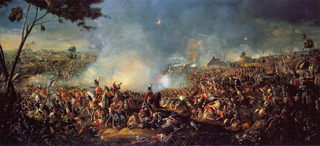
The Battle of Waterloo was fought on Sunday 18 June 1815, near Waterloo, marking the end of the Napoleonic Wars. A French army under the command of Napoleon was defeated by two armies of the Seventh Coalition. One of these was a British-led force with units from the United Kingdom, the Netherlands, Hanover, Brunswick, and Nassau, under the command of Arthur Wellesley, Duke of Wellington. The other comprised three corps of the Prussian army under Field Marshal Blücher; a fourth corps of this army fought at the Battle of Wavre on the same day. The battle was known contemporarily as the Battle of Mont Saint-Jean in France and La Belle Alliance in Prussia.

The Battle of Ligny, in which French troops of the Armée du Nord under the command of Napoleon I defeated part of a Prussian army under Field Marshal Blücher, was fought on 16 June 1815 near Ligny in what is now Belgium. The result was a tactical victory for the French, but the bulk of the Prussian army survived the battle in good order, was reinforced by Prussian troops who had not fought at Ligny, and played a role two days later at the Battle of Waterloo. Ligny was the last victory in Napoleon's military career.
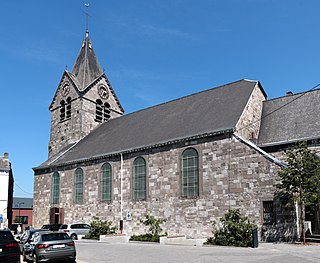
Fleurus is a city and municipality of Wallonia located in the province of Hainaut, Belgium. It has been the site of four major battles.
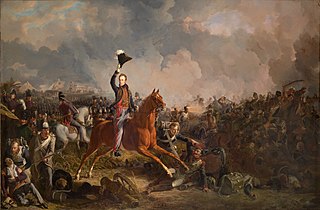
The Battle of Quatre Bras was fought on 16 June 1815, as a preliminary engagement to the decisive Battle of Waterloo that occurred two days later. The battle took place near the strategic crossroads of Quatre Bras and was contested between elements of the Duke of Wellington's Anglo-allied army and the left wing of Napoleon Bonaparte's French Armée du Nord under Marshal Michel Ney. The battle was a tactical victory for Wellington, but because Ney prevented him going to the aid of Blucher's Prussians who were fighting a larger French army under the command of Napoleon Bonaparte at Ligny it was a strategic victory for the French.

The Battle of Wavre was the final major military action of the Hundred Days campaign and the Napoleonic Wars. It was fought on 18–19 June 1815 between the Prussian rearguard, consisting of the Prussian III Corps under the command of General Johann von Thielmann and three corps of the French army under the command of Marshal Grouchy. A blocking action, this battle kept 33,000 French soldiers from reaching the Battle of Waterloo and so helped in the defeat of Napoleon at Waterloo.

The Waterloo campaign was fought between the French Army of the North and two Seventh Coalition armies, an Anglo-allied army and a Prussian army. Initially the French army had been commanded by Napoleon Bonaparte, but he left for Paris after the French defeat at the Battle of Waterloo. Command then rested on Marshals Soult and Grouchy, who were in turn replaced by Marshal Davout, who took command at the request of the French Provisional Government. The Anglo-allied army was commanded by the Duke of Wellington and the Prussian army by Field Marshall Graf von Blücher.

This is the complete order of battle for the four major battles of the Waterloo campaign.

Bothey is a village of Wallonia and a district of the municipality of Gembloux, located in the province of Namur, Belgian.
Major Ludwig Albrecht von Rohr (1796–1815) was a Prussian officer during the Napoleonic Wars who was killed during the Waterloo Campaign.

The Waterloo campaign commenced with a pre-emptive attack by the French Army of the North under the command of Napoleon Bonaparte. The first elements of the Army of the North moved from their peacetime depots on 8 June to their rendezvous point just on the French side of the Franco-Belgian border. They launched a pre-emptive attack on the two Coalition armies that were cantoned in Belgium—the Anglo-allied army under the command of the Duke of Wellington, and a Prussian army under the command of Prince Blücher.

After the fighting at Quatre Bras the two opposing commanders Marshal Ney and the Duke of Wellington initially held their ground while they obtained information about what had happened at the larger Battle of Ligny. They received intelligence that the Prussian army under the command of Prince Blücher had been defeated by the French Army of the North under the command of Napoleon Bonaparte.

On 16 June 1815, the French defeated the Prussians at the Battle of Ligny. The Prussians successfully disengaged and withdrew north to Wavre where they regrouped, and later advanced westward with three corps to attack the right flank of the French army at the Battle of Waterloo. The French were slow to exploit Ligny; Napoleon wasted the morning of 17 June with a late breakfast and touring the previous day's battlefield before organising a pursuit of the two Coalition armies. Napoleon and Marshal Michel Ney took the French reserves to pursue the Duke of Wellington's Anglo-allied army. Marshal Emmanuel de Grouchy was ordered to pursue and harry the Prussians and prevent them from regrouping.

Papelotte Farm is located at Rue Du Dimont a rural road in the Municipality of Braine-l'Alleud around 15 km (9.3 mi) south of Brussels, Belgium. On June 18, 1815, during the pivotal Battle of Waterloo it served as one of the advanced defensible positions of the Anglo-allied army under the command of the Duke of Wellington. Along with the walled farm compounds of Hougoumont and La Haye Sainte, it proved to be instrumental to the delay and the disruption of the opposing Napoleonic army's progress on the battlefield. Napoleon diverted disproportionately large numbers of troops in order to capture or eliminate these perimeters, while he failed to achieve a decisive break through in one of several attacks on the lines of the Allies.
The Trois Burettes Inn was situated at the crossroads of Namur high road and the Old Roman Road, in Belgium. It was a notable location in two battles:

Wagnelée is a village of Wallonia and a district of the municipality of Fleurus, located in the Arrondissement of Charleroi, province of Hainaut, Belgium.
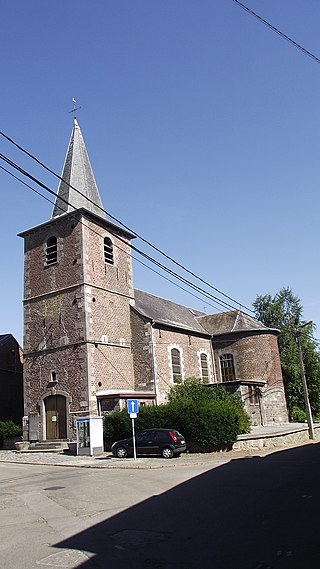
Brye is a village of Wallonia and a district of the municipality of Fleurus, located in the province of Hainaut, arrondissement of Charleroi, Belgium. Its post code is 6222, and telephone zone code is 071.
Tongrenelle is a hamlet of Wallonia in the municipality of Sombreffe, district of Tongrinne, located in the province of Namur), Belgium.
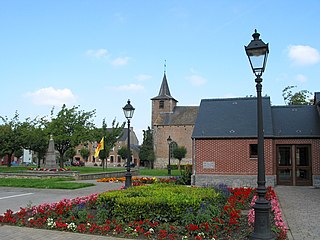
Balâtre is a village of Wallonia and a district of the municipality of Jemeppe-sur-Sambre, located in the province of Namur, Belgium.

Villeret is a hamlet of Wallonia in the district of Saint-Martin and the municipality of Jemeppe-sur-Sambre, located in the province of Namur), Belgium.













